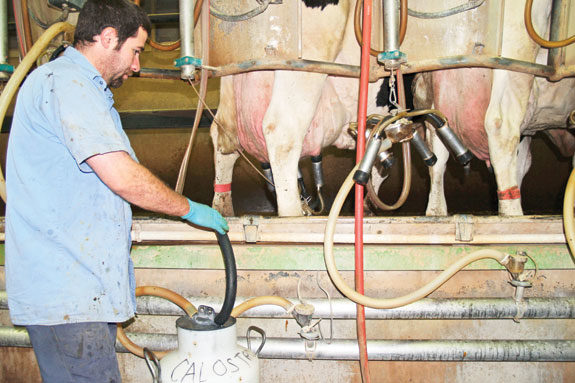Improved antibiotic testing methodology, which utilizes liquid chromatography, now allows milk to be screened for more than 26 different antibiotics and other residues. Although use of this new technology is not mandated, what if it were? Judicious and correct use of medications to treat lactating cows is not only prudent but crucial for every dairyman now and in the future.
I suggest three steps to make sure you are in compliance with all regulations, as well as producing safe and wholesome milk from your dairy.
Health management strategy
Now is the time to re-evaluate your preventative and treatment strategies. Perhaps your treatment programs “are what they are because they got that way.” Some could be outdated, unnecessary or no longer appropriate. Perhaps you were treating every fresh cow or high somatic cell count (SCC) cows. But with improved management, these treatment programs may no longer be necessary or cost-effective.
Changing milk prices and feed costs require you to rethink your culling strategy. Higher levels of involuntary culling are justified in the current high feed cost and moderate milk price scenario. Knowing your “break-even milk” level is crucial in the initial decision “to treat or not to treat.”
For example, at current milk price, it may require 25 lbs of milk to cover fixed costs and an additional 35 lbs of milk to cover feed costs. A cow producing 70 lbs of milk but identified with her third case of mastitis and greater than 150 days in milk may not justify being treated.
Cost of medicine is usually the smallest component of total treatment cost. For most antibiotics that require some period of milk withdrawal, discarded milk accounts for approximately 85 percent of total treatment cost. This is especially true for most intramammary mastitis treatments.
Review all treatment protocols with your veterinarian
Use your veterinarian’s knowledge of pharmacology and disease as well as his/her experience to review all your treatment protocols with you. Most of the drugs used to treat lactating cows require a veterinarian’s prescription. Be certain your veterinarian’s directions for use are clear.
This is especially important regarding withholding times for meat and milk. Dose and route of medicine administration are also important because these affect treatment success as well as withholding times. A specific example is that of Banamine, an anti-inflammatory medicine labeled for administration intravenously only in cattle. It has a 36-hour milk withdrawal time.
Over-the counter-drugs (e.g. penicillin) can be legitimately purchased without a veterinarian’s prescription or order. These are drugs that can be used without the supervision of a veterinarian and whose label has adequate directions for use by a layperson.
However, you are liable for milk residues if use of the product is different than label directions. For example, label directions for penicillin specify using approximately a 12-cc intramuscular injection for a 1,200-lb animal. Under that dose rate, the label specifies a 48-hour milk withdrawal. Using a higher dose necessitates extending the milk withhold time or incurring significant risk for milk residue contamination.
You or your veterinarian needs to write out treatment protocols; you need these available to teach as well as to present to enforcement personnel in the event of residue violation investigation. Then improve your cowside record system to include cow identification, date, diagnosis, treatment and dose, route of administration, technician and meat and milk withdrawal times.
Retrain your herdsmen to follow treatment protocols and withholding times
Treatment protocols are effective only when applied cowside correctly. They present a high risk for residue violation when not adhered to by cowside treatment personnel. It all starts with training herdsmen to make a specific, correct diagnosis.
For example, lameness is not a diagnosis; it is a symptom. Lameness is caused by foot rot, hairy wart, sole abscess, laminitis or injury. Each diagnosis of lameness is treated differently with only one diagnosis, foot rot, requiring systemic antibiotic therapy.
I see a lot of overtreatment with systemic antibiotics for lameness because the foot of a lame cow is not lifted to examine and make a correct diagnosis. Without a physical exam, diagnosis is impossible. Without a diagnosis, applying correct treatment protocols is impossible. Inappropriate treatments are not only expensive, but they also elevate milk and meat residue risk potential.
Herdsmen and cowside workers become very comfortable and confident that their treatment protocols are correct and effective. Changes in sick cow treatments, should you have to make them, will be difficult for good, conscientious workers to make. And bridging the gap of the English/Spanish language barrier can be difficult.
Plan to expend effort and energy working directly with your cowside workers to implement changes, reduce residue risk and improve treatment productivity. Have your veterinarian train and work alongside herdsmen to maximize their training experience. PD
PHOTO
For most antibiotics that require some period of milk withdrawal, discarded milk accounts for approximately 85 percent of total treatment cost. Photo by PD staff.

-
Dr. Tom Fuhrmann, DVM
- Vet/President
- Dairy Works
- Email Dr. Tom Fuhrmann, DVM






